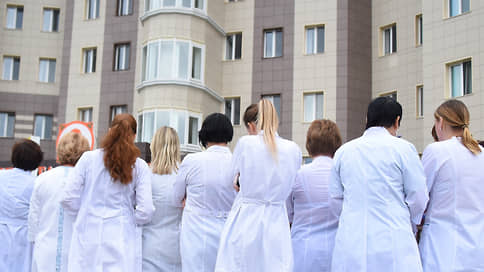Salaries of regional importance – Newspaper Kommersant No. 161 (7362) dated 09/02/2022
[ad_1]

The Ministry of Health recommended that the regions independently adjust the ratio of the fixed and variable components in the salaries of medical workers, as well as take measures to equalize official salaries in this area in similar institutions in the same specialties. In the trade unions of medical workers, who received clarifications from the department on this matter, they believe that such actions will inevitably require additional expenses from the constituent entities of the Russian Federation, which they have nothing to finance.
The Ministry of Health recommended that the regions improve the system of wages in health care at the expense of their own resources. This position of the department is set out in its letter dated August 25 (Kommersant has it), sent to the trade union of healthcare workers in Russia in response to a request on the procedure for calculating additional payments to medical workers for the treatment of patients with coronavirus.
To clarify, earlier the Ministry of Labor reported that in the Russian Federation there is a big difference in the salaries of doctors in different regions of the country, even if they perform the same work. It was formed after the government in the late 2000s delegated the authority to establish wage systems to the regions, and they, in turn, transferred them to the head doctors of medical institutions in almost half of the cases. Since 2012, the regional authorities have evened out the regional differences that have arisen by fulfilling the “May decrees” of the president, according to which the salary of certain categories of workers, including doctors, as well as middle and junior medical staff, should not be lower than 200% of the average for the region’s economy. However, even in cases where this bar was reached, inter-regional differences in wages in the industry persisted.
In addition, the Ministry of Health has repeatedly raised the problem of the ratio of the fixed and variable parts in the salaries of physicians – according to the department’s estimates, the share of salary in total payments in many cases does not exceed 40%. In 2020, the Russian government set itself the opportunity to introduce regulation of the salary structure in various sectors of the economy – a new ratio for healthcare was to be tested during a pilot project of the Ministry of Health and the Ministry of Labor. According to the plan of the departments, within the framework of the new wage system, the salary of medical workers should have been calculated according to uniform rules for all regions and consisted of a salary and incentive and compensation payments. With this approach, the salary share could grow to 64% for junior and middle medical staff, and up to 57% for doctors. However, the Ministry of Health was forced to postpone the implementation of the pilot until 2025, since the Ministry of Finance did not agree with the agency on additional costs to subsidize the salaries of doctors from the federal budget – now they are funded from the compulsory medical insurance system (see Kommersant dated August 23).
In the meantime, as follows from the letter from the Ministry of Health to the trade union, before the delayed start of the pilot project, the regional ministries of health are recommended to “intensify work to improve the remuneration systems for medical workers” and ensure that the salary share in the salary structure does not fall below 55-60% (excluding compensation payments for work in special climatic conditions). Also, the Ministry of Health pointed out, the regions could establish uniform salaries for medical workers in the same type of institutions in the same specialties.
Mikhail Androchnikov, deputy chairman of the trade union of healthcare workers of the Russian Federation (part of the Federation of Independent Trade Unions), believes that the regions can hardly be expected to implement the recommendations of the Ministry of Health in the near future. “All these requirements have long been known in the industry and have been repeatedly voiced by us and representatives of the tripartite commission for the regulation of social and labor relations. In recent years, some regions have listened to them, but most do not have the funds to implement them,” he says. Similarly, Andrey Konoval, the head of the Deystviye medical workers’ union, also assesses the prospects for changing the structure of wages in the industry. “We have been saying for a long time that a doctor’s salary cannot depend on variable payments by more than 10-20%. However, changing its structure will inevitably require additional funding, which is difficult to fit into the regional segments of the CHI system,” he says.
[ad_2]
Source link






